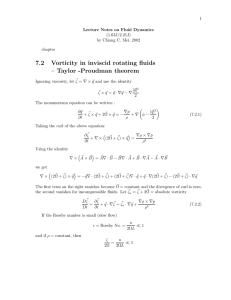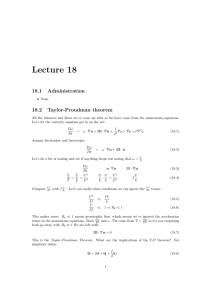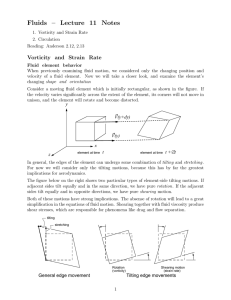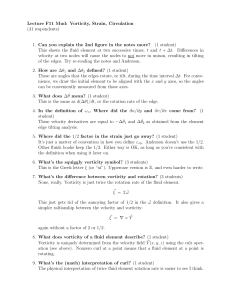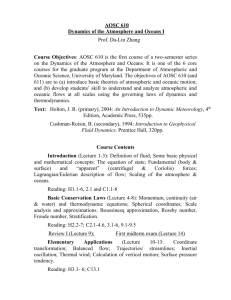Lecture 19 19.1 Administration 19.2
advertisement
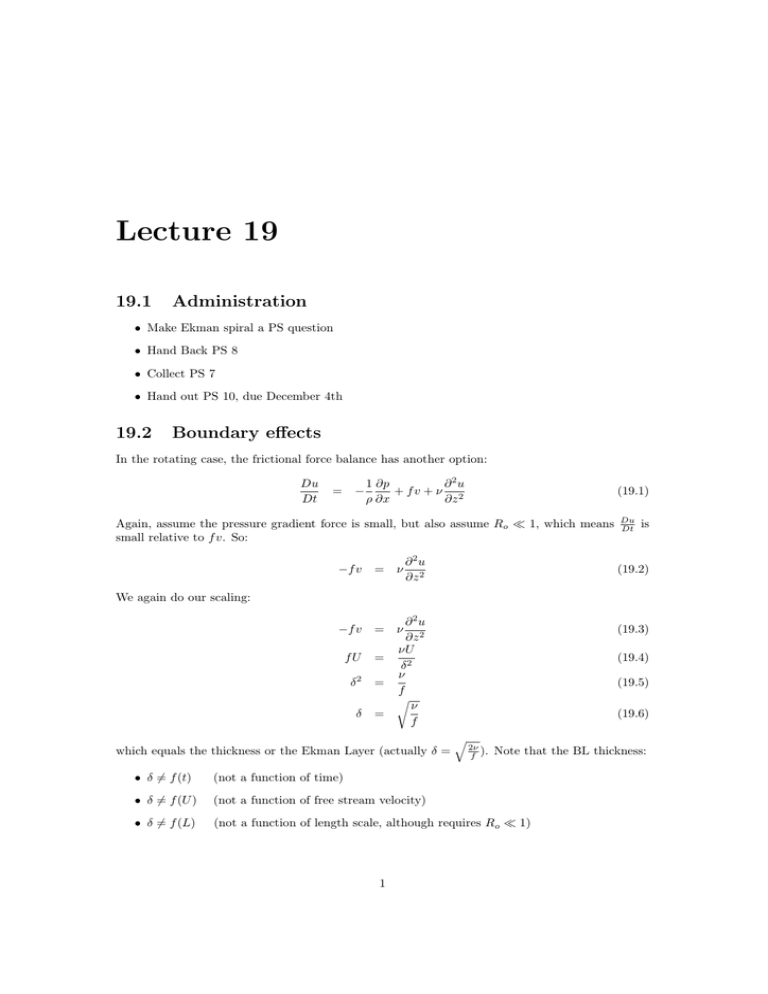
Lecture 19 19.1 Administration • Make Ekman spiral a PS question • Hand Back PS 8 • Collect PS 7 • Hand out PS 10, due December 4th 19.2 Boundary effects In the rotating case, the frictional force balance has another option: Du Dt = − 1 ∂p ∂2u + fv + ν 2 ρ ∂x ∂z (19.1) Again, assume the pressure gradient force is small, but also assume Ro 1, which means small relative to f v. So: −f v = ν ∂2u ∂z 2 Du Dt is (19.2) We again do our scaling: −f v fU δ2 δ ∂2u ∂z 2 νU = δ2 ν = f ν = f = ν (19.3) (19.4) (19.5) (19.6) which equals the thickness or the Ekman Layer (actually δ = 2ν f ). Note that the BL thickness: • δ = f (t) (not a function of time) • δ = f (U ) (not a function of free stream velocity) • δ = f (L) (not a function of length scale, although requires Ro 1) 1 Figure 19.1: (fig:Lec19Shear1, fig:Lec19Shear2) Tilting of planetary vorticity by the shear (left panel) is balanced by the generation of horizontal vorticity by shear (right panel). Figure 19.2: (fig:Lec19Shear3) Boundary layer at ocean’s upper surface. All that matters is your latitude and the viscosity coefficient. The reason the BL thickness doesn’t increase with time is because the generation of horizontal vorticity by shear is balanced by the tilting of planetary vorticity by the shear. −f v Note ωy = ∂u ∂z − ∂w ∂x = ∂u ∂z = ν ∂2u ∂ ∂u =ν ∂z 2 ∂z ∂z (19.7) since w = 0 at the surface: −f v = ν ∂ωy ∂z (19.8) Differentiate without z −f ∂v ∂z = ν ∂ 2 ωy ∂z 2 (19.9) Again, the generation of horizontal vorticity by shear is balanced by the tilting of planetary vorticity by the shear (see figure 19.1). 19.3 Ocean Ekman layer Let’s consider the case of the ocean’s upper surface (see figure 19.2). I want to talk about transport in this, the Ekman layer. Here the equations are −f v fu ∂2u ∂z 2 ∂2v = ν 2 ∂z = ν 2 (19.10) (19.11) ∂2u ∂z 2 ∂2v = µ 2 ∂z ⇒ −f ρv = µ ⇒ f ρu (19.12) (19.13) Think way back to when we derived the viscosity terms in N − S. The µ∇2 u terms fell out of the expression ∇ · τ . Rather than assuming something about the stress/strain relationship, let’s write: −f ρv = f ρu = ∂τx ∂z ∂τy ∂z (19.14) (19.15) Rearrange and write ugly maths (Jim – What is ugly maths?): −ρvdz = ρudz = 1 dτx f 1 dτy f Integrate from the bottom of the frictional layer to the surface: 0 1 τx ρvdz = dτx − f 0 −δ 0 1 τy ρudz = dτy f 0 −δ (19.16) (19.17) (19.18) (19.19) So, − 0 ρvdz = ρudz = ⇒ ME k = −δ 0 −δ = τx f τy f 1 (τ yi − τx j) f τ ×k f (19.20) (19.21) (19.22) (19.23) (Jim – It this last bit correct? It got cut off, I may be off by the sign.) Note that the upper limits of τx and τy are the stress at the ocean surface (the wind stress). The LHS of these equations are the mass transports in the frictional Ekman layer due to the surface stresses on the RHS. The important things to note here are: 1. Transport is to the right of the applied surface stress. 2. Transport is independent of anything we assume about the structure within the Ekman layer. We will return to the hugely important impact of the first point in a bit, but first let’s say something about the structure within the Ekman layer. 19.4 Structure of Ekman Layer We’ll begin with a hand-waving argument. In pressure-gradient-driven flow where friction was important, we had a three-way balance as seen in figure 19.3. We also have a three-way balance in stress-driven flow as seen in figure 19.4. 3 Figure 19.3: (fig:Lec193WayBalance1) Three way balance in pressure gradient driven flow in the presence of friction. Figure 19.4: (fig:Lec193WayBalance2) Three way balance in stress driven flow. Figure 19.5: (fig:Lec193WayBalance3) A layer of fluid feeling the stress from the layer above. Figure 19.6: (fig:Lec19EkmanSpiral1) An Ekman spiral where each successive lower layer velocity (increasing subscript number) is to the right from the above layer and diminished in magnitude. 4 Figure 19.7: (fig:Lec19WindStressOverOcean) Wind stress over the ocean. Imagine the wind stress pushing the tip layer of water in the +x direction. Coriolis turns it to the right, until there is a balance between τ , Co and F . Now consider a layer of fluid immediately below the top layer. It feels a stress from the layer of fluid above it (see figure 19.5). The fluid will be driven in the direction of τ and turned to the right by the Coriolis force until a three-way balance is achieved. This will continue layer by layer until friction removes the velocity imparted by the windstress (see figure 19.6). You end up with a downward spiral of current...called the Ekman Spiral. Ekman spirals have been observed in the ocean, but usually under pack ice or in very fair weather environments. As you might suspect, the details of the Ekman spiral depend on the way you choose to represent the impact of viscosity. If we stick with our ν∇2 u formulation, we can produce one form of the spiral. I debated about whether or not to present this to you, but worried that I might get pushed off the top of the Green Building if I didn’t toe the party line on this one. I’m only going to sketch the solution. Go to pretty much any GFD book for a more formal treatment. I pulled this either out of KC01 or CR94. Start with wind stress over the ocean (see figure 19.7): −f v fu ∂2u ∂z 2 ∂2v = ν 2 ∂z = ν (19.24) (19.25) ∂v Lets take our boundary conditions to be that stress at the surface ⇒ ρν ∂u ∂z = τx and ρν ∂z = 0. Also, √ velocities below the frictional δ are u = v = 0. The approach is to then multiply f u equation by −1 and adding the f u and f v equations together to give ∂2u ∂z 2 = if V ν (19.26) where V = u + iv. You get a solution like: z z u + iv = Ae(1+i) δ + Be−(1+i) δ where δ = 2ν f . (19.27) Applying the boundary conditions wipes out B, and you end up with a solution √ z τx 2 z π u= e δ cos − ρf δ δ 4 √ z τx 2 z π v=− e δ sin − ρf δ δ 4 (19.28) (19.29) Plotting the results as a function of zδ we get the graph shown in figure 19.8. Integrating these expressions for velocity over the depth of the layer gives the designed transport and everything like that. 5 Figure 19.8: (fig:Lec19EkmanSpiral2, fig:Lec19EkmanSpiral2) Horizontal (left) and vertical (right) structures of the Ekman spiral solutions. Note that if imposed on geostrophic flow, friction can increase velocity over geostrophic value! Figure 19.9: (fig:Lec19EkmanConDiv) The top picture shows the convergence of mass leading to a “bump” in the sea surface. The bottom picture shows the divergence of mass leading to a “hole” in the sea surface. 19.5 Ekman layers at the bottom We’ve concentrated on the Ekman layer at the top of the ocean, but of course they also exist at the bottom of the ocean and the bottom of the atmosphere, but the one at the top of ocean is the most interesting: 1. Thickness set by ν and f 2. Transport to right of applied wind stress Let’s talk a bit about the impact of this transport. Imagine the following situation seen in figure 19.9. Convergence of mass leads to a “bump” in the sea surface. The divergence of mass leading to a “hole” in the sea surface. Do we see this in real life? Show Wind stress and SSH pictures (19.10, 19.11) Figure 19.10: (fig:Lec19WindStress) Sample wind stress. 6 Figure 19.11: (fig:Lec19SSH) Sample sea surface height (SSH). Figure 19.12: (fig:Lec19EkmanPumping1) Convergence of mass leads to downwelling, called Ekman pumping. Water doesn’t contribute to pile up over time of course (see figure 19.12). The convergence of mass drives a downward mass flux, called Ekman pumping. When the Ekman transport diverges, we have Ekman suction. This can be quantified. Assume incompressible: ∂u ∂v ∂w + + ∂x ∂y ∂z ∂w ∂z = 0 = −∇xy · uEk (Jim – Can’t read rest, cut off; why not use ∇2 instead of ∇xy .) Integrate: o o dw = dw∇xy · uEk dz −δ −δ o −wEk = −∇xy · uEk dz (19.30) (19.31) (19.32) (19.33) −δ From mass transport ⇒ MEk = uEk dz = o −s o τ ×k ρuEk dz = f −s 1 (τ × k) ρf (19.34) (19.35) Substitute 1 ∇xy · (τ × k) ρf 1 ∇xy · (τy i × τx j) ρf 1 ∂τy ∂τx − ρf ∂x ∂y 1 ∇×τ ·k ρf = − (19.36) wEk = (19.37) wEk = wEk = −wEk (19.38) (19.39) (Jim – You say ∼ 30 m/yr; you may what to say where you might find these rates.) It is the curl of the wind stress that determines the magnitude of the Ekman pumping (or suction). 7 Figure 19.13: (fig:Lec19ConservationofAngularMomentum) If there is water pushed into a column, it must expand. Note there is a bottom Ekman layer as well, but a small contribution in this situation. Figure 19.14: (fig:Lec19EkmanPumping2) Our dA points in the +k direction. 19.6 Response of the interior We have a situation where a viscous layer is pumping water into an assumed geostrophic interior. How does the interior respond? Think conservation of angular momentum (see figure 19.13). If flow is incompressible, pumping water into a column of water will increase the column’s volume. If the height of the column is fixed, the volume must increase by increasing the radius of the column. This increase in r will decrease the column’s angular momentum, and cause it’s relative vorticity to reduce. Even if the column initally had ωz = 0 ⇒ uθ = 0 the presence of planetary vorticity means that increasing r will result in uθ < 0 from DΓa D = (ω + 2Ω) · dA = 0 (19.40) Dt Dt So what? Well, as more and more water is pumped down, uθ gets more and more negative with time. We want to know what’s happening in the... (Jim – Rest got cut off.) That won’t work. We have another option: we can still allow the column of to increase in radius, but offset the tendency to produce negative absolute vorticity generated by the increasing radius by instead moving the column into a region with less planetary vorticity. So if water is pumped down, we will want to generate negative vorticity. By moving our column to the south, the planetary vorticity decreases, so ωz doesn’t have to change and D (ω + 2Ω) · dA = 0 (19.41) Dt A Here 2Ω decreases and dA increases. Let’s quantify this (see figure 19.14). Kelvin’s circulation theorem says: DΓa Dt = D (ω + 2Ω) · dA = 0 Dt (19.42) A Assume that initially ω = 0 and we want to keep ω = 0 so only contribution to the circulation comes from the planetary vorticity in the k direction: D 2Ω sin φdA = 0 (19.43) Dt A 8 Figure 19.15: (fig:Lec19LatY) ∆φ = 2Ω sin φ A DdA Dφ + dA2Ω cos φ Dt Dt f A ∆y ∆φ r ; ∆t DdA 2Ω cos φ + vdA Dt r DdA f + βvdA Dt = ∆y ∇φ ∆t /r; ∇t = vr . = 0 (19.44) = 0 (19.45) = 0 (19.46) A v See figure 19.15 for converting Dφ Dt to r . We want to know how the capping surface area changes with the addition or removal of fluid by Ekman pumping/suction. Easiest if we think in terms of volume: dV = hδA (19.47) d dδA dh (19.48) δV = h + δA = −wEk dA dt dt dt This assumes h is constant – for this derivation, strictly not necessary. Also note that the negative sign is because dv dt > 0 when wEk < 0. dδA (19.49) = −wEk dA dt dδA wEk = − dA (19.50) dt h Note: instead of thinking of this as fluid being pumped into a Lagrangian volume, think of it as a Lagrangian volume getting squished by the pumped water. Thus, for clarity h DdA Dt Substitute = − wEk dA h f wEk dA + βV dA h A fw Ek − + βV dA h − (19.51) = 0 (19.52) = 0 (19.53) A f wEk = βV h (19.54) (19.55) (Jim – Something got cut off here.) The generation negative vorticity by Ekman pumping is balanced by moving fluid containing planetary vorticity into a region of weaker planetary vorticity (causing an increase in vorticity due to conservation of angular momentum). ⇒ Ekman pumping drives an equatorward flow. Recall wEk = 1 ∇×τ ·k ρf 9 (19.56) Figure 19.16: (fig:Lec19SverdrupTransport1) Response of the interior to a wind stress. Figure 19.17: (fig:Lec19WesternIntensification) Western intensification: Return flow is in the form of an intense western boundary current. Now we also know that wEk = hβV f (19.57) Substitute hβv f = v = v = 1 ∇×τ ·k ρf 1 f (∇ × τ ) · k hβ ρf 1 (∇ × τ ) · k hρβ (19.58) (19.59) (19.60) This is Sverdrup Transport. The geostrophic meridional transport in the interior is driven by the curl of the wind stress at the surface (see figure 19.16). But by continuity there must be a return flow. Sverdrup transport is valid everywhere in the interior, so return flow must be on one or both of the boundaries. In the interest of time, let me wave my arms and say it seems sensible that the circulation of the ocean should match the circulation of the atmosphere over the ocean (see figure 19.17). This is most easily understood via a vorticity budget. The wind stress curl is a constant source of negative vorticity. There needs to be a source of positive vorticity to maintain a steady state (see figure 19.18). I just showed how the latitudinal change in the Coriolis parameter is a key player in large scale geophysical flows. I showed that the pumping of fluid into the oceans geostrophic interior Figure 19.18: (fig:Lec19EasternWesternBC) An eastern boundary current adds more negative vorticity (left); a western boundary current adds positive vorticity (right). 10 Figure 19.19: (fig:Lec19SinusoidaVariation) Sinusoidal variation along a latitude band. would, through conservation of angular momentum, lead to negative relative vorticity locally. If the pumping is assumed to be constant, then it will result in an ever-decreasing volume column, which will require an ever-decreasing relative vorticity. Since we’re looking for the steady-state solution, we’re not going to allow this to happen. Instead, we’ll balance the increase in area with a decrease in planetary vorticity: DΓa Dt ⇒ f ωEk h ωEk = 0= D (ωz + f )dx Dt (19.61) A = βν (19.62) < 0 (19.63) Our column of fluid will move south to balance. This is what drives the wind-generated circulation of the ocean. 19.7 Rossby waves Clearly latitudinal changes in the Coriolis parameter are very important for large-scale geophysical flows. The Sverdrup Transport tells us that a varying Coriolis parameter is important when you’re adding fluid to a geostrophic flow from above. Surely it must be important even when no fluid is added? Consider the following situation as seen in figure 19.19. Take fluid lying on a line of constant latitude and impose a sinusoidal variation: Move some fluid south and some fluid north. The fluid moved to the south will develop positive relative vorticity. Why? Fluid in area of relatively high planetary vorticity is moved to a region of lower planetary vorticity. DΓa d (ωz + 2Ω sin φ)dA =0= Dt dt A ⇒ (ωz + 2Ω sin φ)dA = constant (19.64) (19.65) A In the Sverdrup transport case, water was being poured into the fluid column by Ekman pumping and through continuity, the volume of the column increased by an increase in cross-sectional area. Here, continuity says the cross-sectional area must stay the same (if depth is) (Jim – Rest cut off ). So ifdA is going to be constant, and 2Ω sin φ is getting smaller because of an imposed change in φ, for A (ωz + 2Ω sin φ)dA = constant, ωz must become positive. An identical argument can be made for the generation of negative relative vorticity in the hunk of air deplaced poleward. Although it may seem trivial, this point is important enough to stress again: Relative vorticity is generated by displacing a fluid blob to a new latitude, equivalently, the sum of uz and f is conserved. Look back to the situation to visualize the response as seen in figure 19.20. What happens to this pattern over time? The relative vorticity displaces fluid in such a way that the pattern of + and − relative vorticity is maintained and propagates to the west. This 11 Figure 19.20: (fig:Lec19TimeDependence) The wave propagates itself to the West. westward propagation of vorticity max and min constitutes a Rossby Wave. If it’s a wave then it must have a restoring force. A Rossby wave’s restoring force is the meridional gradient of planetary vorticity (for this Rossby wave). 12
